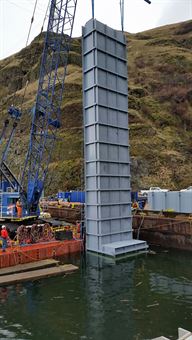the film
forum
library
tutorial
contact
|

|
Corps Helping Salmon Survive this Year by Cooling Lower Snake River
Water at Little Goose and Lower Granite Dams Adult Fish Ladders
by Staff
Clearwater Tribune, August 18, 2016
|
 WALLA WALLA, Wash. - The Walla Walla District of the U.S. Army Corps of Engineers continues to improve adult salmon passage on the lower Snake River to counter the effects of hot summer water on migrating adult salmon and steelhead.
WALLA WALLA, Wash. - The Walla Walla District of the U.S. Army Corps of Engineers continues to improve adult salmon passage on the lower Snake River to counter the effects of hot summer water on migrating adult salmon and steelhead.
Adult sockeye salmon are especially susceptible to high water temperatures due to the timing of their upstream migration. "Thermal barriers" of hotter water can impair their migration. Corps salmon managers cool river water in various ways to help fish survive and migrate.
At Little Goose Lock and Dam, the Corps is using a temporary pumping system this summer to capture cool water from about 60 feet down in the reservoir on the upstream side of the dam and pump it into the fish ladder exit, or upper end of the ladder.
"We're applying lessons learned upstream at Lower Granite," said Roger Golladay, operations project manager at Little Goose. "We're using a system here this year similar to what Lower Granite used in 2014 and 2015 to cool their adult fish ladder."
At Lower Granite, the Corps completed installation in February 2016 of the Adult Fish Ladder Temperature Improvement System. The system is working well. The Corps is seeing fewer adult salmon fall back downstream as they did in the past when encountering thermal barriers in the fish ladder.
Beginning in summer 2013, longer-duration high water temperatures began to occur in Columbia-Snake basin river reaches with and without dams due to unusually hot weather. The Snake River also saw high water temperatures in years before dams were constructed.
Last year was the hottest year on record. More than 510,000 sockeye passed Bonneville Dam including 4,069 sockeye hatched in the Snake River. Eventually, 1,053 of these Snake River sockeye made it to Ice Harbor Lock and Dam, the first dam on the lower Snake River, and 440 of them reached Lower Granite Dam Lock and Dam. This summer 341,531 sockeye passed Bonneville including 1,240 Snake River sockeye. About 886 of those Snake River sockeye reached Ice Harbor and, to date, 788 reached Lower Granite.
As in past years, the Corps utilizes seasonal cool water releases or "flow augmentation" from Dworshak Dam's large reservoir on the North Fork of the Clearwater River in Idaho to cool the lower Snake River. Adjustable selector gates at Dworshak can access deeper, cooler water at various depths, which is released downstream in large quantities to cool the lower Snake River.
At Lower Granite, the new Adult Fish Ladder Temperature Improvement System uses permanent deep-water intake chimneys, which are large vertical structures bolted to the upstream face of the dam. There are two chimneys, one on either side of the upstream end of the fish ladder where adult fish normally continue their upstream migration into the forebay in the reservoir. They both draw water from about 66 to 70 feet deep, depending on forebay water elevation.
- Supplemental water intake chimney - One intake chimney covers the pipe entrance that provides supplemental water to the fish ladder at 'Diffuser 14' starting about 150 feet downstream from the top of the ladder. It also routes water to the adult fish trap.
- Pump intake extension chimney - A second chimney was constructed to extend an existing pump intake. This pump intake provides water to the upstream end of the fish ladder by spraying cooler water in a circular pattern to cool both the immediate forebay area and the fish ladder itself.
As a result, cooler water from approximately 70 feet deep in the dam forebay now supplies both the fish ladder and the adult trap during hot summer months.
The Corps also modified Lower Granite powerhouse and spillway operations to enhance attraction of adult fish to the ladder. Powerhouse operational changes included changing which turbine units were operated. Spillway operational changes included closure of the spillway weir. These adjustments created a cooler water flow profile downstream of Lower Granite to best attract adult salmonids to the fish ladder entrance.
More information about the Lower Granite Adult Fish Ladder Temperature Improvement System, plus downloadable photos, is available on the Walla Walla District website at www.nww.usace.army.mil/Missions/FishPrograms/LowerGraniteFishLadderTemperatureImprovement.aspx.
Additional Walla Walla District fish program information is available at http://www.nww.usace.army.mil/Missions/FishPrograms.
Staff
Corps Helping Salmon Survive this Year by Cooling Lower Snake River Water at Little Goose and Lower Granite Dams Adult Fish Ladders
Clearwater Tribune, August 18, 2016
See what you can learn
learn more on topics covered in the film
see the video
read the script
learn the songs
discussion forum


 WALLA WALLA, Wash. - The Walla Walla District of the U.S. Army Corps of Engineers continues to improve adult salmon passage on the lower Snake River to counter the effects of hot summer water on migrating adult salmon and steelhead.
WALLA WALLA, Wash. - The Walla Walla District of the U.S. Army Corps of Engineers continues to improve adult salmon passage on the lower Snake River to counter the effects of hot summer water on migrating adult salmon and steelhead.
